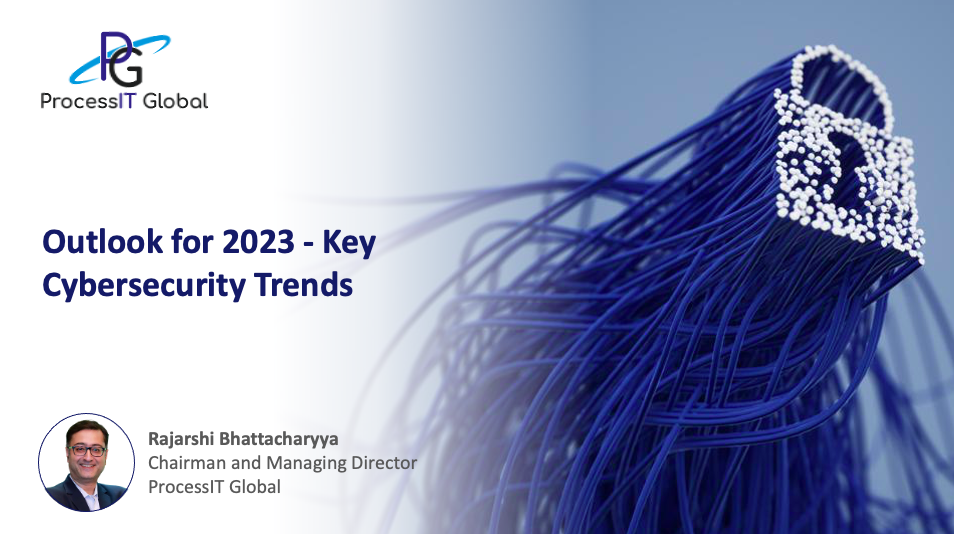Outlook for 2023 - Key Cybersecurity Trends - Rajarshi Bhattacharyya, Chairman and Managing Director, ProcessIT Global

As
we move forward into 2023, the awareness of cyber threats has increased among
many more organizations and individuals.
Businesses are strengthening their defenses to address ransomware and
other cyber threats by leveraging the right security tools and developing
zero-trust architecture. The cybercrime
business is getting more professionalized with ransomware-as-a-service even equipping
criminals who do not have many technical skills. Organizations will witness
more phishing campaigns too. Unfortunately, cybercriminals are adopting all
technical and operating models of legitimate businesses causing huge damage. Some of the key actions that have to be taken
by businesses to remain cyber resilient include restricting network access,
timely patching and updating software, implementing appropriate security tools,
multi-factor authentication, privileged access management, and more!
Let
us take a look at the key developments in the cybersecurity domain that will
dominate the scene in the coming year.
Cyber
resilience will be prioritized to reduce risks
Organizations
must acknowledge cyber resilience as a living process and put a security
strategy with relevant systems and processes across all business units, in
place. IT and business units’ heads have
to be zero complacent about cyber resilience to ensure business
continuity. The approach to achieving
cyber resilience should be scalable, flexible, and adaptable while staying on
the path of continuous improvement. The
right solutions like Identity and Access Management (IAM), Artificial
Intelligence for IT Operations (AIOps), Extended Detection and Response (XDR),
and Next-Generation Network Firewall (NGFW) have to be appropriately deployed. Other important solutions are Security
Information and Event Management (SIEM), Security Orchestration, Automation,
and Response (SOAR), and User and Entity Behavior Analytics (UEBA).
Zero-Trust
(ZT) approach plays a key role
Organizations
have begun to implement the ZT model for cybersecurity and in the coming year,
it will be further embraced. IT security
teams here will not trust any user, device, or network and will thoroughly
verify before providing access. ZT Architecture is considered one of the
effective security strategies to address data breaches across the network and
enhances security both on-premise and in the cloud. Unlike traditional security deployment, in ZT,
security perimeters are not visible.
Furthermore, threat actors are assumed to be present inside the network as
well as outside, so access is provided only after thorough verification.
Adoption
of DevSecOps Framework for faster and secure development
Defined
as the method addressing development, security, and operations across the
application life cycle, DevSecOps is considered faster and more secure
development. The DevSecOps market is
growing rapidly to meet the increasing need for highly secure application
delivery. Higher levels of security and
efficiency are added at every stage of the software delivery lifecycle. Vulnerabilities and attacks are reduced to a
great extent and provide large organizations where it is deployed, several
benefits. Organizations can now enjoy
shorter development life cycles and better operational efficiencies with the
automation process getting enhanced.
DevSecOps solution also helps in reducing costs as issues present, if
any will be eliminated at the initial stages itself. Security will be deployed uniformly
throughout the environment. All hurdles
between solution development, security and operations are removed.
Data
Privacy will take Center-stage
Considered
the new currency, data today is a business asset and enables organizations to
gain business insights that lead to enhanced customer experience. In the current scenario where the line
between offline and online is blurring, managing data privacy is extremely
important. Customers will hesitate to
provide personal information to sellers and will be vigilant while logging into
devices and not casually reveal their credentials in order to avoid misuse of
their information. An effective data protection program should provide clarity
of the sensitive data while establishing who has access to this information. Employees
should be well-trained in securing the data and be involved in data security
responsibilities. Processes and technologies for continuous data protection
should be automated, best practices are to be applied and continuous monitoring
should be ensured.
Growing
demand for Privileged Access Management (PAM) solutions
Privilege
Access Management which is an important aspect of Identity and Access
Management
(IAM)
supports in establishing control over all the key credentials so they are kept
secure.
PAM
solutions deliver multiple advantages to organizations across sectors. It is
the privilege abuse or misuse which is one of the key causes of security
incidents that lead to data breaches. Organizations have to ensure additional
permission is not provided to employees other than that is necessary.
For PAM, the ‘principle of least privilege’ is applied with users able to gain access only to perform their tasks and nothing more. These PAM solutions help the IT security teams, to identify malicious activities with regard to privilege abuse so that immediate action can be taken by them to remediate associated risks. The demand for PAM solutions is high today and according to Allied Market Research, the market size, which was valued at US$2.47 billion in 2020, is estimated to reach US$19.73 billion by 2030.
Cybersecurity
is considered a C-Suite concern today in all organizations, large enterprises,
small and medium businesses, and start-ups, across all industry verticals. Security incidents are complex too, driving
the implementation of new regulations to protect businesses and customers. The Board should form a committee for
cybersecurity to oversee the implementation, ensure costs of security incidents
are significantly reduced, and customers stay and grow while the brand
reputation is maintained.
Investors
will use cybersecurity as a key factor for evaluation. It will also be considered for business
deals, mergers and acquisitions and buying products and services. It can be
said, organizations adopting a robust cybersecurity network architecture,
therefore will succeed on all fronts.



